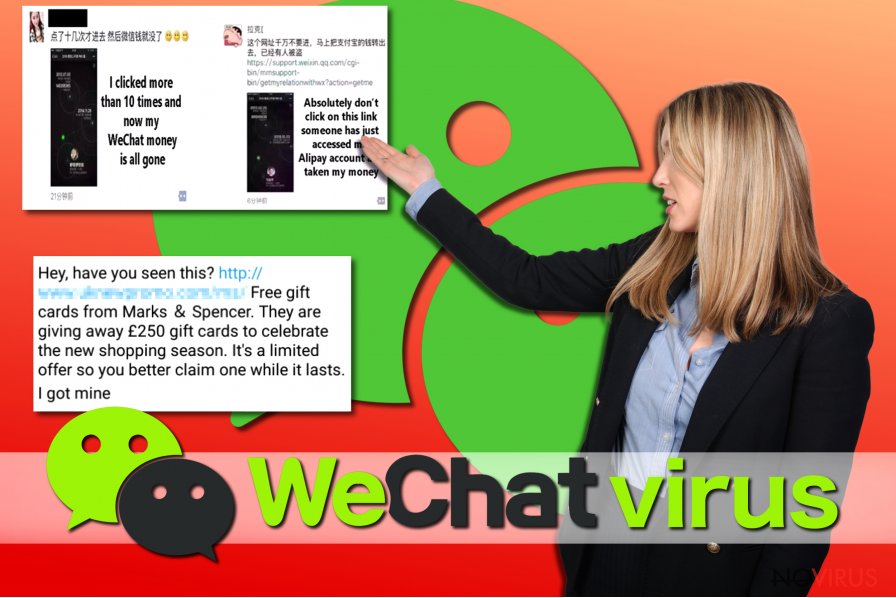Uninstall WeChat virus (Uninstall Guide) - Free Removal Guide
WeChat virus Removal Guide
Description of WeChat virus
WeChat users and their data – cyber crooks' new target

WeChat virus defines a variety of adware, corrupted links, and malicious software posing itself as the well-known utility. The initial purpose of such felony is to wheedle out personal netizens' details and, therefore, money.
WeChat by Tencent, Ltd already claimed its titles as one of the most popular instant messaging utilities. According to ChainaChannel report, it encompasses more than 889 million active users. Originally, it is known as Weixin, which came into daylight on 2011.
Thus, as other numerous online popular services and apps which have already their counterparts: WhatsApp virus, Facebook virus variations, Viber, Gmail, eBay, etc, crooks pointed their daggers to WeChat as well. Note that due to the obscure form of the malware, you may not identify any dubious application to uninstall. However, excessive advertising, constant links to shady web pages might encourage you to look for WeChat virus removal ways. FortectIntego or Malwarebytes might help you do that faster.
Though there are different forms and shades of the malware, there is one particle deviation which stands out. In January 2016, the website ‘The Story of Me and WeChat’ was launched. However, shortly afterward, users started expressing their doubts that the web page contains malware. After visiting the web page, it supposedly clears all the money from Alipay’s account. Luckily, such suspicions turned out to be false.
Furthermore, another major conspiracy about the application occurred in September 2015. In order to carry out their misdeeds, the racketeers crafted a malicious copy of the XCode program, used in creating iOS apps. They named it as XcodeGhost. 
The key functionality of the app granted to steak personal details and then send it to the remote servers monitored by hackers. The possibility to foist it along with the 6.2.5 WeChat version. Consequently, Tencent took immediate measures to remove the affected app from the public access.
Advice how to secure your account:
- do not add unknown people to your contact list
- link your account to a trustworthy email account and the mobile to recover it in the future
- do not trust any one asking for money via the app. In case your contact friend asks for such favour, inquire them again to verify the content of the message
- restrain from disclosing personal details on the app
- do not disclose your Weixin password
- avoid clicking on the links received from unknown senders. Note that even if your friends send you the link, it might be just a harbinger of malware.
Transmission techniques of the malware
Taking into account the fact, that the application is compatible with Android, iOS, iPhone and Android, all users of the latter operating systems may be targeted with WeChat virus versions. If you are about to install the application, download its sample from the official www.wechat.com site.
Downloading the app from secondary sources and especially the ones which are published by ‘unknown’ people might boost the probability to install a corrupted version.
During the installation, opt for the ‘Advanced’ mode which would reveal optional offers. Deselect all relevant add-ons. Lastly, bear in mind the above-suggested tips. Do not forget to make up a complex account password and change it every few months or more often if necessary.
Ways to eliminate WeChat virus
If you have doubts whether you have installed the compromised version of the app, or you noticed unusual behavior while using the application, you may apply removal methods. One of the optimal options is to scan the device with malware elimination tool. This utility will remove WeChat virus and its components.
In case, you are dealing with a more elaborate version of the malware, you may need to reboot the device into Safe Mode. Below you will find further instructions how you can do it effectively. Then, you will be able to complete WeChat virus removal. If you are looking for a way how to get rid of the infection on Android, check the following elimination guidelines.
Getting rid of WeChat virus. Follow these steps
In-depth guide for the WeChat elimination
Pick a reliable anti-spyware elimination tool for eliminating Weixin virus. Delete the infection after restarting the system in Safe Mode with Networking.
Important! →
The elimination guide can appear too difficult if you are not tech-savvy. It requires some knowledge of computer processes since it includes system changes that need to be performed correctly. You need to take steps carefully and follow the guide avoiding any issues created due to improper setting changes. Automatic methods might suit you better if you find the guide too difficult.
Step 1. Launch Safe Mode with Networking
Safe Mode environment offers better results of manual virus removal
Windows 7 / Vista / XP
- Go to Start.
- Choose Shutdown, then Restart, and OK.
- When your computer boots, start pressing the F8 button (if that does not work, try F2, F12, Del, etc. – it all depends on your motherboard model) a few times until you see the Advanced Boot Options window.
- Select Safe Mode with Networking from the list.

Windows 10 / Windows 8
- Right-click the Start button and choose Settings.

- Scroll down to find Update & Security.

- On the left, pick Recovery.
- Scroll to find Advanced Startup section.
- Click Restart now.

- Choose Troubleshoot.

- Go to Advanced options.

- Select Startup Settings.

- Press Restart.

- Choose 5) Enable Safe Mode with Networking.
Step 2. End questionable processes
You can rely on Windows Task Manager that finds all the random processes in the background. When the intruder is triggering any processes, you can shut them down:
- Press Ctrl + Shift + Esc keys to open Windows Task Manager.
- Click on More details.

- Scroll down to Background processes.
- Look for anything suspicious.
- Right-click and select Open file location.

- Go back to the Process tab, right-click and pick End Task.
- Delete the contents of the malicious folder.
Step 3. Check the program in Startup
- Press Ctrl + Shift + Esc on your keyboard again.
- Go to the Startup tab.
- Right-click on the suspicious app and pick Disable.

Step 4. Find and eliminate virus files
Data related to the infection can be hidden in various places. Follow the steps and you can find them:
- Type in Disk Cleanup in Windows search and press Enter.

- Select the drive (C: is your main drive by default and is likely to be the one that has malicious files in) you want to clean.
- Scroll through the Files to delete and select the following:
Temporary Internet Files
Downloads
Recycle Bin
Temporary files - Pick Clean up system files.

- You can also look for other malicious files hidden in the following folders (type these entries in Windows Search and press Enter):
%AppData%
%LocalAppData%
%ProgramData%
%WinDir%
After you are finished, reboot the PC in normal mode.
Eliminate WeChat using System Restore
-
Step 1: Restart your computer in Safe Mode with Command Prompt
Windows 7 / Vista / XP- Go to Start → Shutdown → Restart → OK.
- As soon as your computer starts, start pressing F8 key repeatedly before the Windows logo shows up.
-
Choose Command Prompt from the list

Windows 10 / Windows 8- Click on the Power button at the Windows login screen, and then press and hold Shift key on your keyboard. Then click Restart.
- Then select Troubleshoot → Advanced options → Startup Settings and click Restart.
-
Once your computer starts, select Enable Safe Mode with Command Prompt from the list of options in Startup Settings.

-
Step 2: Perform a system restore to recover files and settings
-
When the Command Prompt window appears, type in cd restore and press Enter.

-
Then type rstrui.exe and hit Enter..

-
In a new window that shows up, click the Next button and choose a restore point that was created before the infiltration of WeChat and then click on the Next button again.


-
To start system restore, click Yes.

-
When the Command Prompt window appears, type in cd restore and press Enter.
It is strongly recommended to take precautions and secure your computer from malware attacks. To protect your PC from WeChat and other dangerous viruses, you should install and keep a powerful malware removal tool, for instance, FortectIntego, SpyHunter 5Combo Cleaner or Malwarebytes.
How to prevent from getting malware
A proper web browser and VPN tool can guarantee better safety
As online spying becomes an increasing problem, people are becoming more interested in how to protect their privacy. One way to increase your online security is to choose the most secure and private web browser. But if you want complete anonymity and security when surfing the web, you need Private Internet Access VPN service. This tool successfully reroutes traffic across different servers, so your IP address and location remain protected. It is also important that this tool is based on a strict no-log policy, so no data is collected and cannot be leaked or made available to first or third parties. If you want to feel safe on the internet, a combination of a secure web browser and a Private Internet Access VPN will help you.
Reduce the threat of viruses by backing up your data
Due to their own careless behavior, computer users can suffer various losses caused by cyber infections. Viruses can affect the functionality of the software or directly corrupt data on your system by encrypting it. These problems can disrupt the system and cause you to lose personal data permanently. There is no such threat if you have the latest backups, as you can easily recover lost data and get back to work.
It is recommended to update the backups in parallel each time the system is modified. This way, you will be able to access the latest saved data after an unexpected virus attack or system failure. By having the latest copies of important documents and projects, you will avoid serious inconveniences. File backups are especially useful if malware attacks your system unexpectedly. We recommend using the Data Recovery Pro program to restore the system.







